Science Fiction With Real Humans: The Best of James Blish
The Best of James Blish (Del Rey, 1979). Cover by H. R. Van Dongen
The Best of James Blish (1979) was the twenty-first (and penultimate!) installment in Lester Del Rey’s Classic Science Fiction Series. (Only one more to go!) Science fiction author Robert A. W. Lowndes (1916–1998) provided the introduction — his only one in the series. Sci-fi artist H. R. Van Dongen (1920–2010) provides the ninth cover in the series, the most used artist of the series.
James Blish (1921–1975) was an American science fiction and sometimes fantasy author. He was one of the original Futurians, and besides writing oodles of short fiction and novels, he became also well-known for writing a series of Star Trek novelizations with his second wife J. A. Lawrence. According to Wikipedia, Blish is credited with inventing the term “gas giant” to refer to large planetary bodies. Blish is someone I had never read before, but whose name often comes up in discussion of classic science fiction.
Some of the best selling science fiction of the 60s & 70s: Blish’s Star Trek volumes
All of the authors in these Del Rey Best ofs — both living and passed at the time of publication — usually “cut their teeth” in the pre-WWII pulps. And the editors of these volumes usually included one or two early tales from that pulp era. However, in general and in my opinion, those early stories are usually not all that great.
Such was Blish’s 1940 “Citadel of Thought,” which is really just a space romp with a scantily clad woman/heroine by the protagonist’s side, while sciency-sounding, gobbledy-gook explanations are poured out by the hero, which are supposed to make the details more plausible. In essence, I think such explanations were probably considered essential for these pulp tales to count as science fiction back then. But from our contemporary perspective, this sort of stuff feels lame. For an early generation of sci-fi fans, I’m sure they were great.
But Blish’s story-telling craft clearly improved as his 1949 “The Box” makes clear. The story takes place in New York when suddenly a dome mysteriously appears over New York City (The Simpsons? Stephen King?) imprisoning the city’s residents. Blish builds some very good tension here as he explores the scientific ramifications, including quickly building ozone levels and depleting oxygen. I was pretty hooked at the beginning. The protagonist, a scientist, comes to the eventual rescue as his scientific theorizing provides a means of getting rid of the dome. There is also some hand-waving, sciency talk here as well to explain the problem and solution. But the story is much more interesting and the info dumps less annoying and more believable.
An assortment of James Blish’s science fiction
Blish improved, in my eyes, with his 1950 “There Shall Be No Darkness,” which is almost a straightforward werewolf story. However, the lycanthropy is explained by genetics and hormone imbalance, thus, I guess, making it a “science fiction” tale. I’m not sure that I’d say the science sounded more plausible here, but the scares (and a couple of surprises) were done so well that as a reader I didn’t really care about credibility. Regardless of whether it counted as good science fiction, this was definitely a good horror tale.
I enjoyed “Surface Tension,” one of Blish’s more famous stories (it’s portrayed on the front cover), and the longest in the book. It’s the story of an implanted, miniature underwater civilization started by a group of scientists who crash land on some habitable planet. Though the scientists die, their creation comes to conscious life, beginning their Darwinian fight for survival and eventual discovering — what else — science! I can see why this is one of Blish’s most beloved tales. It was unique — not quite like any other sci-fi tale I can remember. The story primarily focuses on how these aquatic humanoids rise to figuring out how to “travel to the stars” by first realizing that there is another world above the water they live in. Their “spacecraft” was plausibly described, and very inventive on Blish’s part. I found myself rooting for these tiny “astronauts” as they made their journey upwards. Definitely a great read.
Another great story I can’t fail to include here is “The Oath.” Set in a post-apocalyptic future Earth, the story focuses upon the practice of technological medicine (as can best be practiced) versus sorts of home-brew healthcare existing on the fringes of post-nuclear society. What starts out like a predictable story that will laud the benefits of modern medicine, turns into an intriguing and very detailed philosophical discussion about the overall purposes of human healthcare. Blish provides a plausible and very human story about how medicine might be practiced on the borderlands of nuclear holocaust and asks us to think about the purpose of healthcare in the here and now. An excellent story.
James Blish paperbacks
As an aside, during my reading of this book I also came across another Blish horror story, “More Light” (1970) in Chaosium’s The Hastur Cycle. It’s written in the world and style of Robert W. Chambers’ “The King in Yellow” (1895). It was very creepy and increased my growing admiration of Blish’s writing.
I have a couple of summary thoughts on The Best of James Blish. One, Blish’s fiction, I think, should be characterized as “a thinking man’s” fiction. For those interested in sci-fi extrapolations of ideas, technologies, and their effects upon future peoples, Blish is a must-read. The more I’ve read sci-fi, the more I’ve realized that my own personal tastes drift more towards fantasy and horror. But Blish’s intellectual subject matter I often found very engaging. These do not feel like “engineer” stories, space adventures, or let-me-show-you-how-much-science-I-know kind of stories (though a few of Blish’s earlier tales did feel like that). Blish engages with sci-fi ideas in plausible and interesting ways, showing possible real-world effects on real-feeling human beings.
Second, like many of the other Del Rey volumes, The Best of James Blish really shows the deep growth of this author over time. From pulp-era to modern, Blish grew in his portrayal of interesting ideas and, more importantly, he grew in his depth of characterization and representation of human (and sometimes not so human) psychologies in various situations. Blish’s characters feel like very real people — and not just in melodramatic, soap opera ways. He does an excellent job of presenting plausible actions and reactions. Blish’s characters are not cardboard cutouts.
I will be sure to be on the lookout for more Blish in the future. I highly recommend The Best of James Blish.
Here’s the complete Table of Contents:
Science Fiction the Hard Way, by Robert A. W. Lowndes
“Citadel of Thought” (Stirring Science Stories, February 1941)
“The Box” (Thrilling Wonder Stories, April 1949)
“There Shall Be No Darkness” (Thrilling Wonder Stories, April 1950)
“Surface Tension” (Galaxy, August 1952)
“Testament of Andros” (Future Science Fiction, January 1953)
“Common Time” (Science Fiction Quarterly, August 1953)
“Beep” (Galaxy, February 1954)
“A Work of Art” (Science Fiction Stories, July 1956)
“This Earth of Hours” (Fantasy and Science Fiction, June 1959)
“The Oath” (Fantasy and Science Fiction, October 1960)
“How Beautiful With Banners” (Orbit #1, 1966)
“A Style in Treason” (Galaxy, June 1970)
“Probapossible Prolegomena to Ideareal History,” by James Blish [as by William Atheling, Jr. ] (Foundation 13, May 1978)
The Best of James Blish was published in August 1979 by Del Rey Books. It is 379 pages in paperback, originally priced at $1.95. The cover is by H. R. Van Dongen. It is out of print. There is no digital edition.
20 volumes of the Ballantine Classics of Science Fiction (missing Weinbaum, Del Rey, and Brunner)
Our previous coverage of the Classics of Science Fiction line includes (in order of publication):
- The Best of Stanley Weinbaum by James McGlothlin (1974)
- The Best of Henry Kuttner by James McGlothlin (1975)
- The Best of Cordwainer Smith by James McGlothlin (1975)
- The Best of C. L. Moore by James McGlothlin (1976)
- The Best of Frederik Pohl by James McGlothlin (1976)
- The Best of John W. Campbell by James McGlothlin (1976)
- The Best of C. M. Kornbluth by James McGlothlin (1977)
- The Best of Philip K. Dick by James McGlothlin (1977)
- The Best of Fredric Brown by James McGlothlin (1977)
- The Best of Edmond Hamilton by Ryan Harvey (1977)
- The Best of Leigh Brackett by Ryan Harvey (1977)
- The Best of Robert Bloch by James McGlothlin (1977)
- The Best of Murray Leinster by James McGlothlin (1978)
- The Best of L. Sprague De Camp, by James McGlothlin (1978)
- The Best of Jack Williamson by James McGlothin (1978)
- The Best of Raymond Z. Gallun by James McGlothlin (1978)
- The Best of Lester del Rey by Jason McGregor (1978)
- The Best of Eric Frank Russell by James McGlothlin (1978)
- The Best of Hal Clement by James McGlothin (1979)
- The Best of James Blish by John O’Neill (1979)
- The Best of Fritz Leiber by James McGlothlin (1979)
- The Best of John Brunner by John O’Neill (1988)
See all of our recent Vintage Treasures here.
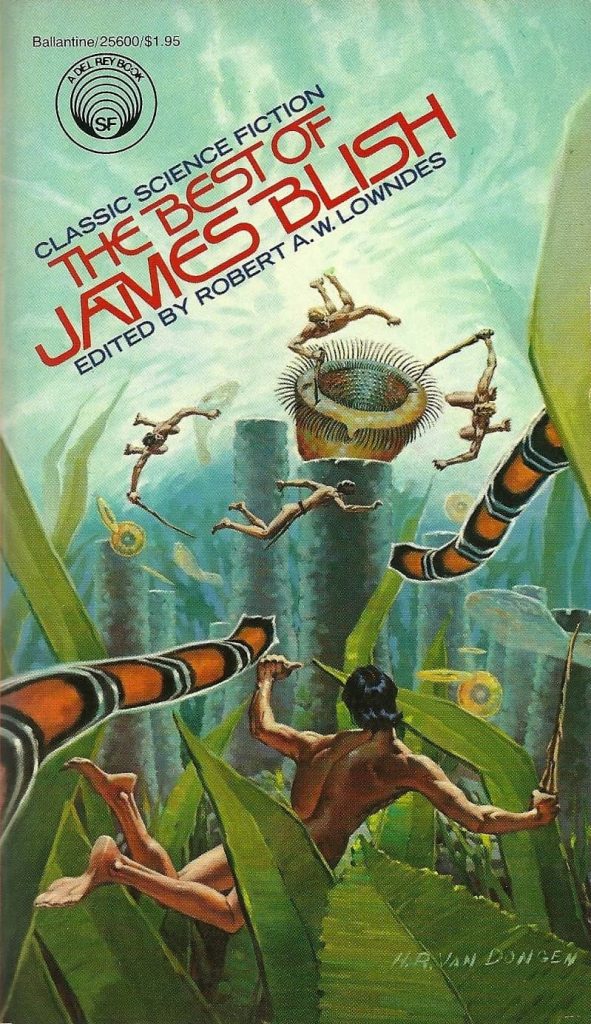
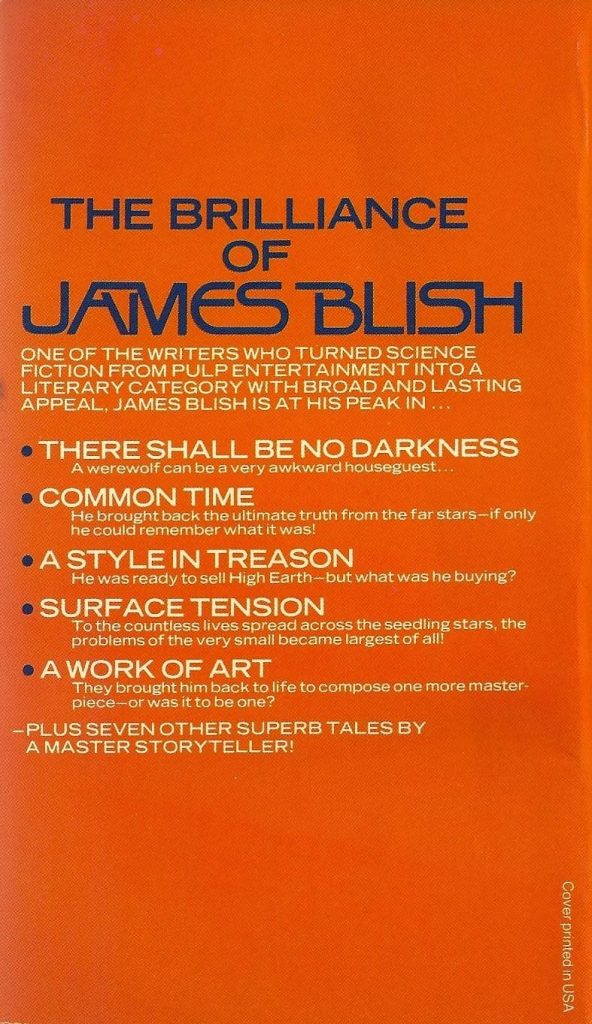
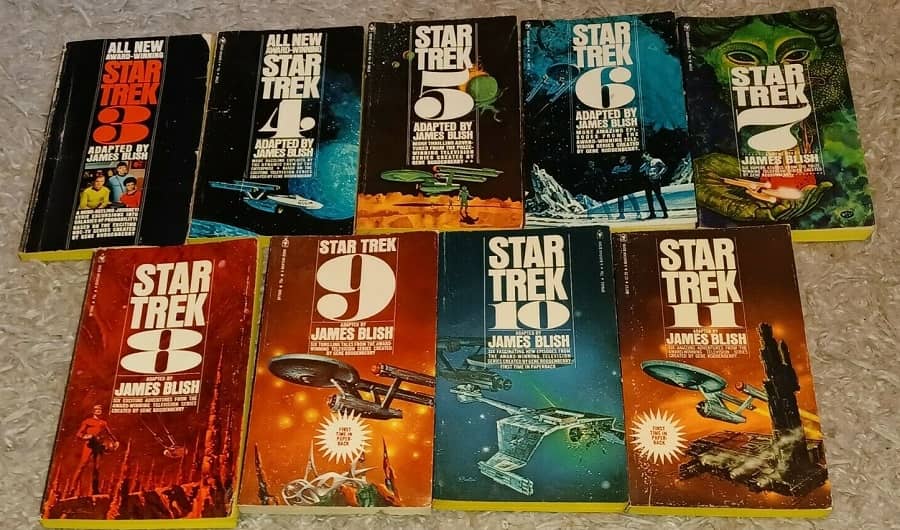
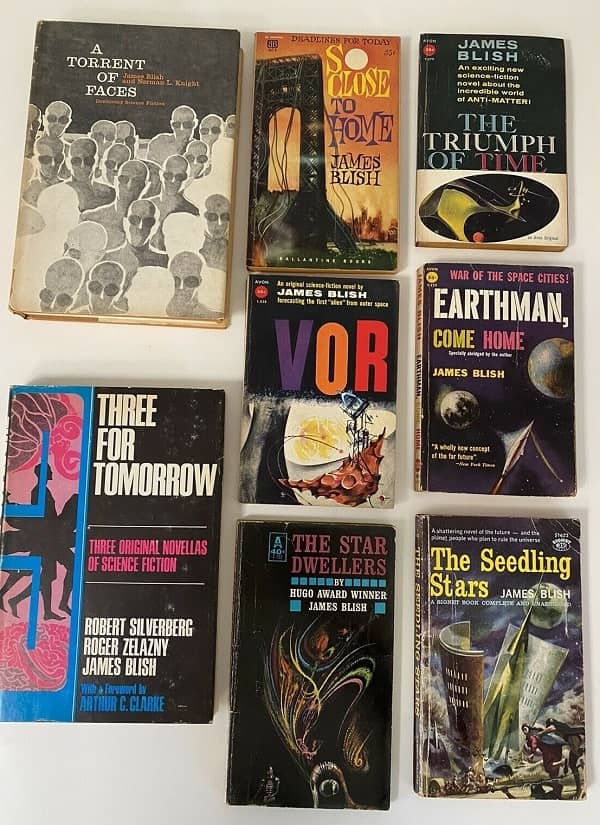
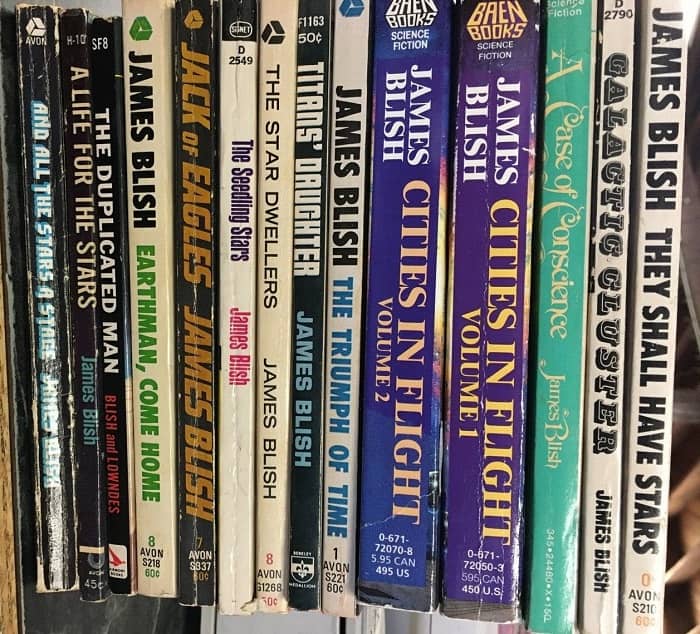
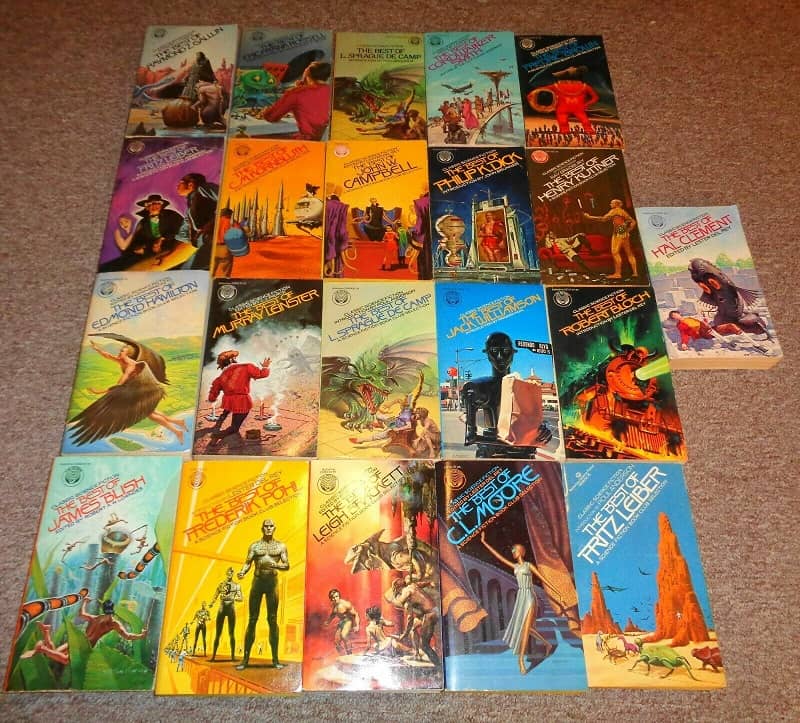
Blish was definitely one of the most interesting SF writers of his generation.
Common Time is a great story, and A Case of Conscience a great novel.
What I read f Cities in Flight felt too pulpy to me, though.
I’ve heard many good things about Blish’s Conscience novel. Thanks for the recommendation.
Like you, I’m familiar with the name rather than the work. A former employee of the tobacco institute, Blish died of lung cancer at 54 – irony of ironies! – which only makes his sheer output all the more impressive.
“Common Time” is the best of his stories that I’ve read. And I never thought I’d ever enjoy a werewolf story until I read “There Shall Be No Darkness”. But I agree with Knut Jørgen about the Cities in Flight series. Those are not his best.
I doubt that I’ll seek out anymore Blish. But if I come across him in an anthology I’m reading, I’ll look forward to his story. Thanks for the warning about Cities in Flight series.
I like Mr. Blish’s science fiction and think of him as a “homie” (he born in East Orange, me in Orange, NJ), but his strength might have been in science fantasy, in which I would include his “After Such Knowledge” works, including his most popular work, A Case of Conscience, his historical fiction on Roger Bacon, Doctor Mirabilis, and my favorites, Black Easter and The Day After Judgement, which depict the consequences of opening the gates to Hell in the nuclear era.
I remember The Day After Judgement cover back in the 80s. Hmmm . . . might have to track that one down.
I must look out for Surface Tension, it sounds fascinating. Have the Four Square (NEL) version of Galactic Cluster awaiting an imminent read
It definitely was fascinating. My brief summary did not spoil anything. You’ll love it.
Great review!
I like Blish a lot–maybe a little more than he deserves. But A Case of Conscience is genuinely great, as are a handful of his stories (e.g. “Common Time”, “Testament of Andros”, “A Style in Treason”). His “More Light” is genuinely creepy, and has the added inside joke of Blish interacting with a character called William Atheling jr (the pseudonym under which he wrote much of his early criticism). His pantropy stories, based on the idea that humankind would have to adapt to the planets rather than vice versa were collected in The Seedling Stars (and it includes “Surface Tension” and its companion “Sunken Universe”).
They have weaknesses, but I also like Jack of Eagles (his 1950s novel of psychic powers) and Midsummer Century (an odd book about a man thrown into the far future). He wrote the first original Star Trek novel, Spock Must Die!, which is worth reading at least once, although it never could have been canon. (Blish’s worldview was maybe a little more vindictive than Roddenberry’s.)
The Okie stories were Blish’s attempt to write what he called “intensively recomplicated” stories, like A.E. Van Vogt’s. Damon Knight, an early critic of Van Vogt, called them “kitchen sink” stories. They have highs and lows, especially in the first and last volumes in the series.
Thanks for the bringing “more light” to the inside joke of Blish’s horror story. By the way: “Morlock lives!”
[…] 1966, the publisher Bantam Books acquired the Star Trek license. Veteran science fiction author James Blish was hired to write novelizations of each episode. Blish hated the idea of tie-in fiction and had […]